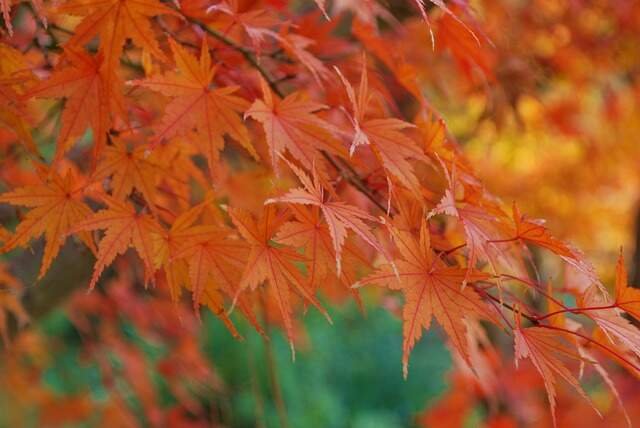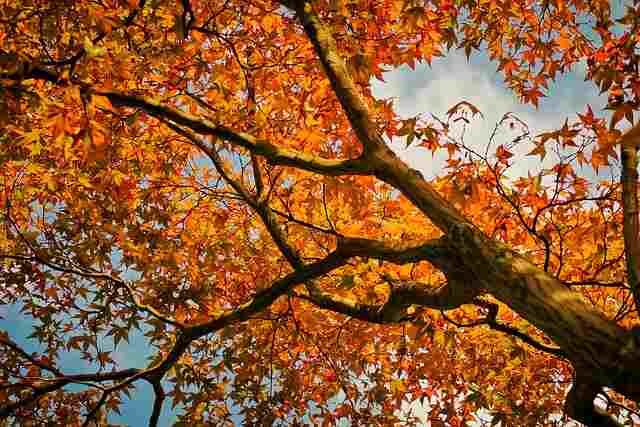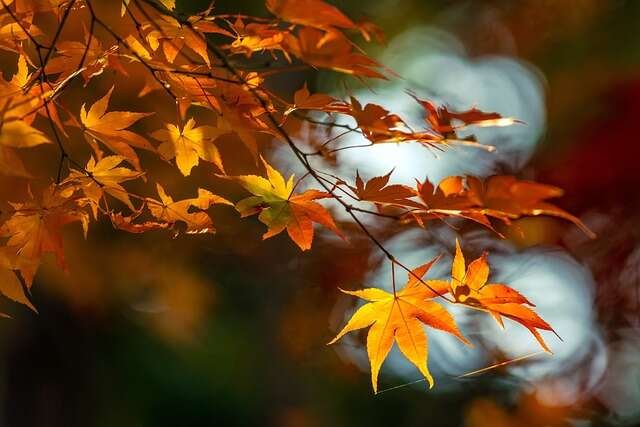Hi guys, in today’s article, we are gonna talk about Japanese maples – Acer palmatum – and how to grow them successfully in containers. I’m gonna share with you a few tips on how to choose a Japanese maple for your balcony or patio garden. We are gonna repot a Japanese maple; I’m gonna share with you what potting mix you will need, and we are going to talk a little bit about soil pH and how that affects the health of your plant. Then we are going to talk about maintenance, so how to take care of your Japanese maple so that it grows healthy and beautifully. We’re also going to mention a few issues that can occur and how to fix those issues. So let’s begin today’s article.
Basic Information
Okay, you guys, let’s begin with a few basic pieces of information about Japanese maples. Japanese maples are small, deciduous trees. Deciduous means they drop their leaves during winter. They have spectacular leaf color; obviously, they look great in spring and summer, but then in autumn, they put on a beautiful color show. They are slow-growing, so they are perfect for being grown in containers, and they are best grown in zones 5-8. That means they are winter-hardy down to zone 5, where the coldest temperatures are between -20 and -10 degrees Fahrenheit (-23 and -12 degrees Celsius). So they are very frost-resistant, but they also have that upper limit of zone 8. In zones above 8, in warmer climates, winters are just not cold enough for them to enter dormancy. They need to enter dormancy; they need to enter that resting period because if they just keep on going without a rest, then they will exhaust themselves and they will slowly start to die. Zones five through eight are the best for growing Japanese maples.

Choose a Japanese Maple
Okay, so now let’s talk about how to choose a Japanese maple for your balcony or for your patio garden. There are so many cultivars to choose from. They vary slightly in height, they vary obviously in leaf color, in leaf shape, but even in growing habit. I have a Japanese maple, Acer ‘Orange Dream’, that is upward-growing, and my other Japanese maple, Acer ‘Garnet’, has a more drooping habit. So there are really a lot of cultivars to choose from. The first thing that you will need to take into consideration before buying a Japanese maple is the aspect. What is the sun exposure on your balcony? Japanese maples are best grown in partial shade, ideally morning sunlight protected from harsh afternoon sun. Generally, the darker the leaves, the more sun they can handle, and the lighter the leaves, the less sun they can handle. Those very light-colored green and yellow leaves, variegated leaves, they tend to burn if they get too much sun. So if you have a North-facing balcony where there’s not a lot of direct sunlight, then green leaves, yellow leaves, variegated leaves, these will be best for your situation. If you have a little bit more sun on your balcony, let’s say an east-facing balcony, then reds and purples would do well because not only can they handle a bit more sun, but they also will color up better if they are provided with a bit of sun. But that being said, if you have a very hot, very sunny balcony, south-facing acers will struggle in these conditions because the soil will dry up really quickly, and they can get leaf scorch. I’m not saying that you can’t buy a Japanese maple if you have a south-facing balcony, but they will struggle a bit, and you can expect that they will get leaf scorch and they will require more maintenance.
Wind
The second thing to take into consideration is wind. Acers don’t appreciate strong winds. The wind will cause foliage damage; it will cause leaf scorch, and the leaves will just simply dry up because of the wind. But don’t get discouraged just yet. I know that a lot of balconies are very windy. My balcony is super windy. This exact Acer fell in the wind countless times, and the pot was broken at least three times. But it’s really important to keep them well-watered because as the plant loses moisture through the leaves, it pulls moisture from the soil to substitute for that moisture loss. Day-to-day winds are not gonna cause a lot of damage if you keep your Acer well-watered, but if there are really strong winds in the forecast, I like to take my Acers and put them in a sheltered position, like in some corner of my balcony. I do it only, as I said, when there are really strong winds in the forecast. Normally, I just keep them where they are and I keep them well-watered, and it helps a lot with foliage damage caused by the wind.
Repot a Japanese Maple
Okay, now let’s talk about how to repot a Japanese maple. I’m going to share with you a clip that I recorded earlier this spring of how I’m repotting this Acer ‘Orange Dream’. In this clip, I talk about container choice, potting mix, and soil pH, and after that clip, we are going to talk about maintenance.
Hi, so in this part of the article, we are going to talk about how to repot your Japanese maple. The best time to do it is when your plant is dormant, so that’s between autumn and spring. You could repot it in winter if the weather is mild enough, but ideally, you will do it once your plant lost its leaves in fall or late winter/early spring before it leafes out again. For the choice of container, there are several things to take into consideration. Obviously, if you have a smaller tree, you will choose a smaller container; if you have a larger tree, you will choose a larger container. Japanese maples like their soil to be moist, so if you choose a smaller container, obviously, the soil will dry out quicker. Also, because Japanese maples are trees, they are tall plants. If you have a windy balcony, you will need a large container to provide stability for your plant. Because the pot was so small that whenever there was a wind, the canopy of the tree would catch the wind and just fall. The tree would fall on the floor. So, for the stability of your plant, I suggest that you choose something that is large and heavy like terracotta, for example. But if you’re worried about the weight limit and you don’t want to choose large and heavy containers like terracotta, you could choose a plastic pot. But then, if you are going to choose a plastic pot, I would go with a square container because a square pot is less likely to be knocked down by the wind. Obviously, the container has to have drainage holes at the bottom for water to evacuate easily.

Potting
Okay, so now let’s talk about potting mix. What potting mix should you choose for your Japanese maples? If you have a very small tree, like those little baby Japanese maples that you can sometimes buy at the garden center or at the grocery store even, if you have a very small tree, then you can totally use multi-purpose or universal potting mix. But if you have a slightly larger tree or a more mature tree,then I would definitely go with a loam-based potting mix, also called soil-based potting mix. The difference between the two is that the multi-purpose contains different types of peat so it drains really quickly, it leaches out nutrients pretty quickly, doesn’t hold on to much moisture, and the soil-based potting mix is first of all heavier in weight, so yet again, it provides more stability, more anchorage to your plant, but it also holds on to more moisture and more nutrients. So definitely choose a loam-based potting mix for your mature trees and shrubs. Because Japanese maples like slightly acidic soil, not as acidic as, for example, Camellias or Rhododendrons, your typical acid-loving plants, but I like the soil to be slightly acidic. First of all, it will grow healthier if you provide a little bit of acidity, but also, it will have better autumn coloring because, obviously, we also grow Japanese maples for their beautiful autumn colors. So ideally, you would mix half and half, loam-based potting mix and ericaceous potting mix. Don’t go 100% ericaceous potting mix because that will be too acidic. So ideally, half and half, loam-based and ericaceous potting mix. That’s what I’m gonna do right now.
Drainage
Obviously, the container has to have drainage holes at the bottom. I’m not putting any layer of clay balls, gravel, anything at the bottom at all because it’s absolutely unnecessary. It can actually impede drainage, and we want as much space for the root development as we possibly can without blocking the drainage holes. So I’m gonna first measure how much soil I need to put at the bottom. You would want to plant your Japanese maple at the exact same depth as it was in its previous container, even slightly higher so that the first flare of roots is slightly exposed. So that will be about here. So I’m gonna fill the container, as I said, half and half with ericaceous potting mix and loam-based potting mix. I’m just gonna cut through the roots a little to release the compaction. Make sure that the plant is positioned straight in the pot. Even if the plant is, let’s say, if you have a plant that is growing slightly at an angle, correct it by positioning it straight in your new container, even if that means that you plant the root ball at an angle. After planting, obviously water your Japanese maple until the water comes out of the drainage holes.
Watering
So now let’s talk about maintenance. The first task on the maintenance list is obviously watering. Acers like a lot of moisture; they do not like to dry out, and they do not like to stay dry for a long time. So keep your Acers well-watered. But obviously, there is a slight difference between a plant being well-watered and a plant being overwatered. So what is overwatering? What causes overwatering is actually not the amount of water that you give but the frequency of watering. So water your Acers well; water it until you see water coming out of the drainage holes, and then allow the top layer of soil to slightly dry out. When you stick a finger inside the pot and if it still feels really wet, do not water. Wait for the top layer of soil to slightly dry out before you water again.
Fertilizing
The second maintenance task is obviously fertilizing. You have to feed your Acers; you have to provide them with nutrients, with minerals so that they can grow healthy and develop properly. There are two ways you can do it. Whatever fertilizer you choose, I suggest that you use an organic fertilizer. You can either buy slow-release general-purpose fertilizer, those granulated fertilizers that you spread on top of the soil in spring, then you gently scratch them into the soil surface, or you can use liquid fertilizers. I personally prefer liquid fertilizers; I use organic seaweed fertilizers, and I fertilize my Acers weekly from spring from the moment that they leaf out until the end of summer.
Pruning
The third maintenance task is pruning. Japanese maples don’t require pruning actually. I mean, you don’t have to prune them unless it’s for some aesthetic purposes. For example, if you have dead, damaged, or diseased branches, those need to be cut out. But if you want to keep your Acer at a certain height or if you want to keep it in a certain form or shape, that’s the only times when you will prune your Japanese maple. If you are going to do it, do it in summer when the leaves are on and when you see what you are doing so there’s less risk that you’re going to misshape the plant. You can do it in winter as well if you feel confident enough, but the only time of the year when you wouldn’t want to prune your Japanese maple is in spring because in spring they are more prone to bleeding. So in the place where you are going to make the cut, the wound is gonna bleed sap, and you wouldn’t want that, so either summer or winter.
Overwintering
Next task – overwintering. As we said, Japanese maples are very winter-hardy; they are hardy down to zone five. So if you live in zone five, you probably should protect your Japanese maple because even though they are hardy down to zone five, when they are grown in containers, they are a little bit more fragile. So in zone five, you will protect them, but in zones above five, you do not need to protect them for the winter time. The only thing that can happen is in spring when they start to leaf out, those fresh young leaves are very tender, so if you have a late spring frost, it can cause leaf damage to those fresh leaves. If that happens, just trim those leaves off, and then your Japanese maple should grow new fresh leaves later on. In winter, you will have to give them a splash of water if there is no moisture, like if there’s no snowfall, no rainfall, or if you have your Japanese maples under a roof, let’s say you have a balcony with a roof or you have a patio that is covered and your Japanese maples don’t receive any moisture. If you notice that the soil is very dry, give them a splash of water. Not very often; check on them every two to three weeks. If the soil looks really dry, then give them a splash of water because, as I said, they do not like to be completely dry at any time of the year.
Mulching
And the last task is mulching. I highly recommend that you mulch your potted Japanese maples. Mulch has many benefits; it helps to retain moisture, it suppresses weeds, it keeps roots isolated from frost in winter and protected from the sun in summer. So how I like to mulch all of my containers actually, all of my potted plants, I add a layer of compost or worm castings. For example, for Japanese maples, I will use acidic compost to add that acidity every year. I add something more decorative like pebbles or bark or something like that, and I refresh that mulch every spring.
Just one last thing that I wanted to say at the end is that if you just bought your Japanese maple or if you have a very young tree and it doesn’t look as beautiful as my Acer ‘Garnet’ here, that’s normal. The more they mature, the more beautiful they become. So just be very patient; take good care of your Acer, and in a few years’ time, it should reward you. It should put on a beautiful show like that, so that’s nothing to worry about. My Acer was pretty bald when I bought it, and now it has so many leaves. But this tree is several years old. So as I said, the more they mature, the better they look.
Okay, so that’s it for today’s article. I hope that you found it helpful.



